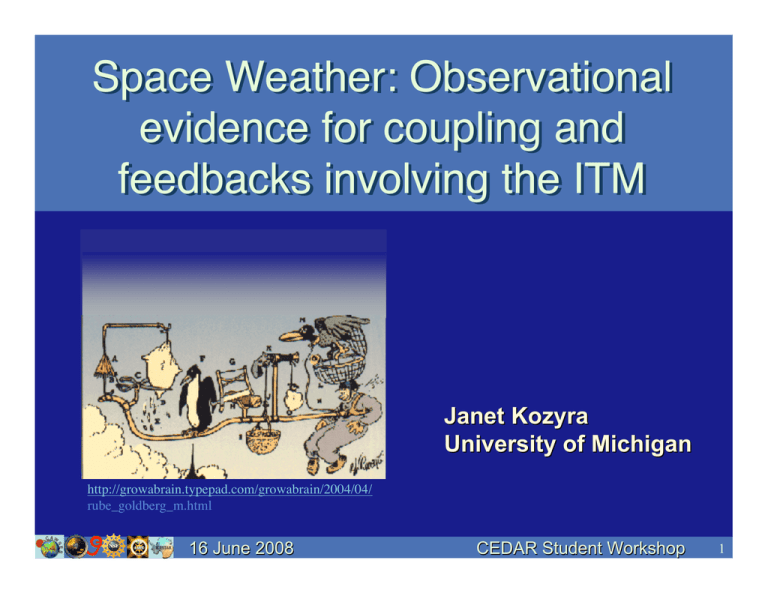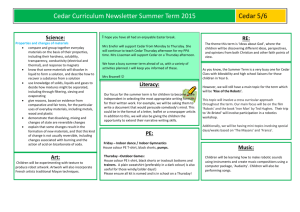Space Weather: Observational evidence for coupling and feedbacks involving the ITM Janet
advertisement

Space Weather: Observational evidence for coupling and feedbacks involving the ITM Janet Kozyra University of Michigan http://growabrain.typepad.com/growabrain/2004/04/ rube_goldberg_m.html 16 June 2008 CEDAR Student Workshop 1 The Sun & Earth form a complex system which has characteristic properties Prediction is difficult based on knowledge of components alone Disney’s WALL-E (http://adisney.go.com/ disneyvideos/animatedfilms/wall-e/ “The whole is greater than the sum of the parts “ 16 June 2008 CEDAR Student Workshop 2 The Sun & Earth form a complex system which has characteristic properties Prediction is difficult based on knowledge of components alone History matters http://www.aps.org/publications/apsne ws/200406/butterfly-effect.cfm “Butterfly Effect” 16 June 2008 CEDAR Student Workshop 3 The Sun & Earth form a complex system which has characteristic properties Prediction is difficult based on knowledge of components alone History matters Emergent features Still from “The Mummy” Mummy”, Universal Pictures, 2008 “Science of Surprise” 16 June 2008 CEDAR Student Workshop 4 The Sun & Earth form a complex system which has characteristic properties Prediction is difficult based on knowledge of components alone History matters Emergent features Negative and positive http://en.wikipedia.org/wiki/Rube_Goldberg_machine feedbacks “Simple cause & effect are rare.” 16 June 2008 CEDAR Student Workshop 5 The Sun & Earth form a complex system which has characteristic properties Interactions between components define behavior Not contained in the individual pieces Break into smaller digestible pieces -- lose behavior 16 June 2008 CEDAR Student Workshop 6 Close-Up on the Upper Atmosphere Remember what we are dealing with ….. 16 June 2008 CEDAR Student Workshop 7 Evidence for Active ITM Influences throughout Geospace Four coupling pathways: Mass & momentum outflows Solar wind energy inflow Fundamental physics: Ion-neutral coupling Cross-scale coupling Active electrodynamic interactions auroral auroralparticles particles subsiding subsiding NO-rich NO-rich air air auroral auroral zone zone polar polar vortex vortex Isolation Isolation from from other other latitudes latitudes Reactive species: production & transport 16 June 2008 Chemicaldynamical coupling CEDAR Student Workshop 8 Evidence for Active ITM Influences throughout Geospace Four coupling pathways: For this talk concentrate on …. Mass & momentum outflows Solar wind energy inflow Fundamental physics: Ion-neutral coupling Cross-scale coupling Active electrodynamic interactions auroral auroralparticles particles subsiding subsiding NO-rich NO-rich air air auroral auroral zone zone polar polar vortex vortex Isolation Isolation from from other other latitudes latitudes Reactive species: production & transport 16 June 2008 Chemicaldynamical coupling CEDAR Student Workshop 9 Mass and Momentum Outflow Ionospheric Outflow: 2-Step Process Outflow: Acceleration to > escape velocity Outflows best correlated with solar wind Pdyn fluctuations: Reason Unknown [c.f. Fok et al., 2005] Upwellling: Increase in scale height Another “upwelling” process: horizontal transport of enhanced Ne patches After Strangeway et al., [2005] as summarized in Moore and Horwitz, 2007 and Lotko, 2007 16 June 2008 CEDAR Student Workshop 10 Mass and Momentum Outflow SED Dayside TOI 12 800 km 18 Multiple TOIs, different sources Ne 06 80 70 60 Accumulating evidence that most of the mass, momentum, and energy coupling occurs on relatively small spatial scales. Patch being created Schunk, GEM tutorial, 2006 16 June 2008 CEDAR Student Workshop 11 Mass and Momentum Outflow patch patch patch patch Sondrestrom view of polar cap patch ions energized in nightside auroral zone. Adapted Adapted from from Semeter Semeter et et al. al. 2003 2003 in in Lotko Lotko 2007 2007 review review H+ O+ HS OS Gardner Gardner & & Schunk, Schunk, 2005 2005 16 June 2008 Structured ion outflow creates structured neutral outflow through charge exchange CEDAR Student Workshop 12 Mass and Momentum Outflow Structured energy inputs Solar wind (Poynting flux, Joule heating, energy inflow soft precipitation) and convecting ionospheric density structures Effects plasma waves, Cause structured ring current & rad belt “upwelling” of composition, charge ions, polar wind exchange losses & jets, neutral holes Structured atmospheric loss Patchy plasma sheet composition. Variable oxygen geocorona Lotko [2007], Sojka and Schunk references 16 June 2008 Neutral & Ion Outflows Charge exchange & O backsplash from H/H++ auroras creates neutral O outflows Further acceleration by waves and fieldaligned potentials at high altitude cause oxygen outflows CEDAR Student Workshop 13 Oxygen ions dominate the magnetospheric plasma during extreme events in the inner region. Patchy composition. O+ more than 90% of energy density (at 6-8 RE) !! O+ can dominate even for more moderate solar and magnetic activity levels. Variability due to multiple drivers. [Greenspan & (10/03) (3/91) (2/86) Hamilton, JGR, 2002] Nose et al., JGR, 2005 16 June 2008 CEDAR Student Workshop 14 Ever-present <50 eV oxygen outflow LENA sees at least 2 neutral O populations under all conditions: Higher energy auroral O Earth limbs • A neutral hot O geocorona • A higher energy upflowing O population originating from the auroral zone. Possibly due to backsplash O from H/H++ auroral precipitation [Shematovich, Shematovich, et et al al., 2006] These upward O fluxes increase in intensity with increasing magnetic activity to a few x 1099 cm-2-2s-1-1. 16 June 2008 ram Hot O geocorona Wilson et al., 2003; 2005 CEDAR Student Workshop 15 Suggested positive feedbacks on magnetotail stability Produces more frequent and/or more intense auroral activity Saturation of the polar cap potential breaks positive feedback loop. Lotko, 2007 Increased demand for episodic unloading of tail flux 16 June 2008 Ionospheric outflow from auroral activity feeds O++ into magnetotail Magnetotail stability Mass loads convection in magnetosphere, slows reconnection rate Less O++ in dayside plasma sheet implies faster dayside merging Slower nightside reconnection rate cannot balance the dayside rate CEDAR Student Workshop 16 Evidence for the mass-loading of reconnection flows Consequences (review Moore & Horwitz, 2007): (1) reduces Alfven speed of inflow to the dayside reconnection region, (2) slows reconnection, (3) reduces convection 16 June 2008 Observed occurrence rate of cold convecting ions at the dayside magnetospher e for northward (left) and southward (right) IMF [Chen and Moore 2006]. CEDAR Student Workshop 17 Evidence mass-loading by drainage plume slows reconnection Extension of ionospheric plasma into the inner magnetosphere ~10% effect for Ne < 10 cm-3 plumes. However, Ne can reach 100 cm-3 Sign of weakened coupling to the solar wind & evidence for decreased reconnection rate. Borovsky & Denton, 2006 Important component of mass circulation not included in MHD models 16 June 2008 CEDAR Student Workshop 18 ITM Mass Loading of Magnetospheric Convection Solar Wind Electric Field Reduces reconnection rate, pc, pc, & outflows Increases pc, pc, enhances convection Mass Loading of Convection Massloading slows convection Model result: Winglee et al., 2002, as summarized by Lotko, 2007 16 June 2008 Greater centrifugal acceleration of upflows More ionospheric outflow Higher O+ content of plasmasheet CEDAR Student Workshop 19 ITM Mass Loading of Magnetospheric Convection As mass-loading increases in multi-fluid model, the convection potential drops toward values predicted by AMIE model based on magnetometer data [Winglee et al., 2002] 16 June 2008 CEDAR Student Workshop 20 Summary • ITM is an active participant in Geospace system. Not just a boundary condition. • Growing evidence that mass & momentum flows and electrodynamic parameters are all structured by the ITM. • Coupling occurs on small spatial & temporal scales. • Structured ion outflows produce structured neutral outflows • Coupling involves a broad range of scales, fluid & kinetic processes & varies in complicated ways with solar wind drivers • Fundamental questions in the magnetosphere and middle atmosphere cannot be answered without a more complete knowledge of ITM processes 16 June 2008 CEDAR Student Workshop 21 Highest priority ITM problems related to Geospace system science • Understand how fundamental ITM processes work so we can recognize their signatures at the system level • New ways of observing global patterns of energy inputs, basic state parameters, and electrodynamic quantities. Climatologies are not sufficient. • Determine what spatial and temporal scales are needed • Tackle the challenges & take the steps that will lead to a revolution in our understanding of geospace as a tightly coupled system of systems 16 June 2008 CEDAR Student Workshop 22 Future Measurement Requirements • Multi-point observations connecting solar • • • • driving to auroral field-aligned transport Connection between ionospheric (also plasmaspheric) structures, transport & outflows. Ion - neutral interactions NOx in the polar night. Quantities related to transport ITM Complex System: Instantaneous global patterns of energy inputs and electrodynamic parameters. 16 June 2008 CEDAR Student Workshop 23







